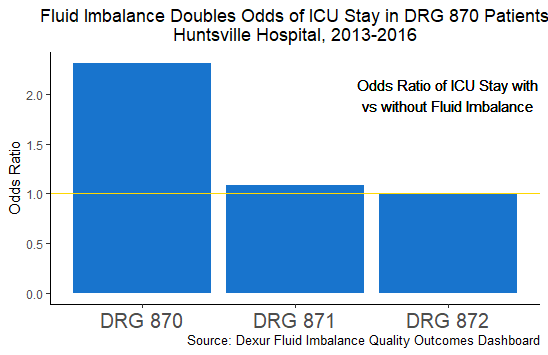How to Evaluate the Impact of Fluid Imbalances on Sepsis Patients: Part 3: ICU Stays
In Fluid Imbalance
Get Dexur’s Personalized Hospital Specific Presentation on Quality, Safety, Compliance & Education
By: James Pitt Aug. 14, 2018
Sepsis is strongly associated with intensive care. 54.7% of sepsis patients required ICU stays in 2014, with a median 5 day length of stay in ICU and 10 day length of stay overall, according to Rhee et. al (2017) in JAMA. Dexur has previously reported that fluid imbalance is associated with higher odds of ICU stay in patients with infections, including sepsis with major complications, at hospitals in Arkansas.
As a case study, Dexur analysts examined ICU stays in sepsis patients at Huntsville Hospital (AL). In patients with fewer than 96 hours of mechanical ventilation (DRG 871 and DRG 872), patients with fluid balance were not much more likely to have ICU stays than patients who did not. But in patients with more than 96 hours of mechanical ventilation (DRG 870), those with fluid imbalance were twice as likely to have ICU stays as those without fluid imbalance.

Reducing ICU admissions may help hospitals control costs. According to the Agency for Healthcare Research and Quality, “From 2002 through 2009, ICU stays rose at three times the rate of general hospital stays without an increase in severity of illness.” In this period, hospital stays with ICU services accounted for 26.9% of discharges, but 47.5% of aggregate total hospital charges.
Few studies compare sepsis patients who receive intensive care to sepsis patients who do not. Mearelli et. al (2014) reviewed research in Europe, concluding that sepsis patients treated outside ICU were older, but less likely to have organ dysfunction or perfusion abnormalities, than those admitted to ICU. Similarly, Rohde et. al (2013) found that patients with more affected organ systems were more likely to have ICU stays, at a US academic medical center. Meaudre et. al (2017) found that sepsis patients with higher lactate concentrations (a widely used predictor of mortality) were more likely to have ICU stays.
ABOUT THE AUTHOR
